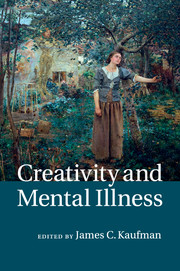Book contents
- Frontmatter
- Dedication
- Contents
- List of figures
- List of tables
- List of contributors
- Preface
- Acknowledgments
- Part I Creativity and mental illness: the state of the field
- Part II Cognitive and neuroscientific perspectives on creativity and mental illness
- Part III Creativity and the spectrum of mental illness
- 9 Creativity and the spectrum of affective and schizophrenic psychoses
- 10 When good is bad and bad is good: mood, bipolarity, and creativity
- 11 Attention-deficit/hyperactivity disorder and creativity: ever the twain shall meet?
- Part IV Creativity and mental illness: possible commonalities
- Part V Creativity and mental health
- Part VI Creativity and mental illness: what now?
- Index
- References
10 - When good is bad and bad is good: mood, bipolarity, and creativity
from Part III - Creativity and the spectrum of mental illness
Published online by Cambridge University Press: 05 August 2014
- Frontmatter
- Dedication
- Contents
- List of figures
- List of tables
- List of contributors
- Preface
- Acknowledgments
- Part I Creativity and mental illness: the state of the field
- Part II Cognitive and neuroscientific perspectives on creativity and mental illness
- Part III Creativity and the spectrum of mental illness
- 9 Creativity and the spectrum of affective and schizophrenic psychoses
- 10 When good is bad and bad is good: mood, bipolarity, and creativity
- 11 Attention-deficit/hyperactivity disorder and creativity: ever the twain shall meet?
- Part IV Creativity and mental illness: possible commonalities
- Part V Creativity and mental health
- Part VI Creativity and mental illness: what now?
- Index
- References
Summary
The meeting of affect and cognition
Arguably, one of the most significant new developments in psychological research during the last 30 years is the exploration of the interface between affect and cognition (see De Houwer and Hermans, 2010; Lewis et al., 2008; Power and Dalgleish, 2008). A new perspective on the interface between emotion and cognition is emerging, in which the emphasis is on the interwoven and internal rather than the conceptually external relations between the two (e.g., Damasio, 1994). Another major emphasis has been on the constructive roles that affect can play in cognitive functions as opposed to previous conceptions, where affect was rather one-sidedly seen as detrimental to rational and effective thought (Forgas, 1995, 2008).
The meeting of affect and creativity
In the same period we have also witnessed a significant rise in research on creativity, seen as a scientifically respectable and empirically tractable phenomenon (e.g., Hennessey and Amabile, 2010; Kaufman and Sternberg, 2010). It is to be expected that these two new streams of research on affect and creativity, respectively, would interface. This has indeed happened, and we can now look back on a 25-year-long roster of research on the relationship between mood and creativity (Baas et al., 2008; Rank and Frese, 2008).
- Type
- Chapter
- Information
- Creativity and Mental Illness , pp. 205 - 235Publisher: Cambridge University PressPrint publication year: 2014
References
- 8
- Cited by



